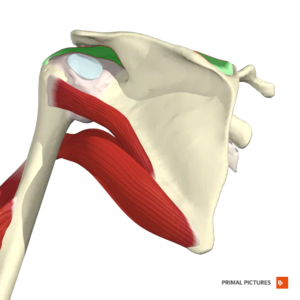Full Can Test
Top Contributors - Shreya Pavaskar, Kim Jackson, Amanda Ager, Jonathan Wong and Rucha Gadgil
Purpose[edit | edit source]
The Full Can Test is used to assess the function of Supraspinatus muscle and tendon of the shoulder complex.
Technique[edit | edit source]
The patient can be seated or standing for this test, holding their arm in 90° of elevation in scapular plane (30° anterior to the frontal plane) with full external rotation of the glenohumeral joint. In this position, the patient's thumb should be pointing up. The therapist should stabilize the shoulder while applying a downward force to the arm whilst the patient tries to resist this motion. This test is considered positive if the patient experiences pain or weakness with resistance to the shoulder complex.[1]
Evidence[edit | edit source]
Kelly et al. reported that the full-can test for assessment of supraspinatus function which had similar electromyographic (EMG) activity compared with the Empty Can Test , but that it provoked less pain. Their findings showed no significant difference in supraspinatus muscle activation with variation in humeral rotation. There is slightly less activation of the infraspinatus muscle leading to a better isolation of the muscle. [3] It is also suggested that in this testing position, there is less activity of surrounding muscles such as deltoid and subscapularis.[4]
The Full Can Test had a sensitivity of 70% (95% CI=59% to 82%) and a specificity of 81% (95% CI=74% to 88%)[5].
Additional Resources[edit | edit source]
Anatomy of Shoulder - Acromioclavicular joint, Glenohumeral joint, Sternoclavicular joint and Scapulothoracic joint
Examination of shoulder and Special tests
Common conditions - Adhesive Capsulitis, Biceps Tendonitis, Rotator Cuff Tears and Shoulder Instability.
References[edit | edit source]
- ↑ Timmons MK, Yesilyaprak SS, Ericksen J, Michener LA. Full can test: Mechanisms of a positive test in patients with shoulder pain. Clinical Biomechanics. 2017 Feb 1;42:9-13.
- ↑ Physiotutors. Full Can Test ⎟ Shoulder Impingement. Available from: https://www.youtube.com/watch?v=NuBOHdm20cc [last accessed 2/12/2020]
- ↑ Kelly BT, Kadrmas WR, Speer KP. The manual muscle examination for rotator cuff strength: an electromyographic investigation. The American journal of sports medicine. 1996 Sep;24(5):581-8.
- ↑ Lee CK, Itoi E, Kim SJ, Lee SC, Suh KT. Comparison of muscle activity in the empty-can and full-can testing positions using 18 F-FDG PET/CT. Journal of orthopaedic surgery and research. 2014 Dec;9(1):1-8.
- ↑ Jain NB, Luz J, Higgins LD, Dong Y, Warner JJ, Matzkin E, Katz JN. The diagnostic accuracy of special tests for rotator cuff tear: the ROW cohort study. American journal of physical medicine & rehabilitation. 2017 Mar;96(3):176.







